Maytag MHWC7500YW Owner's Manual
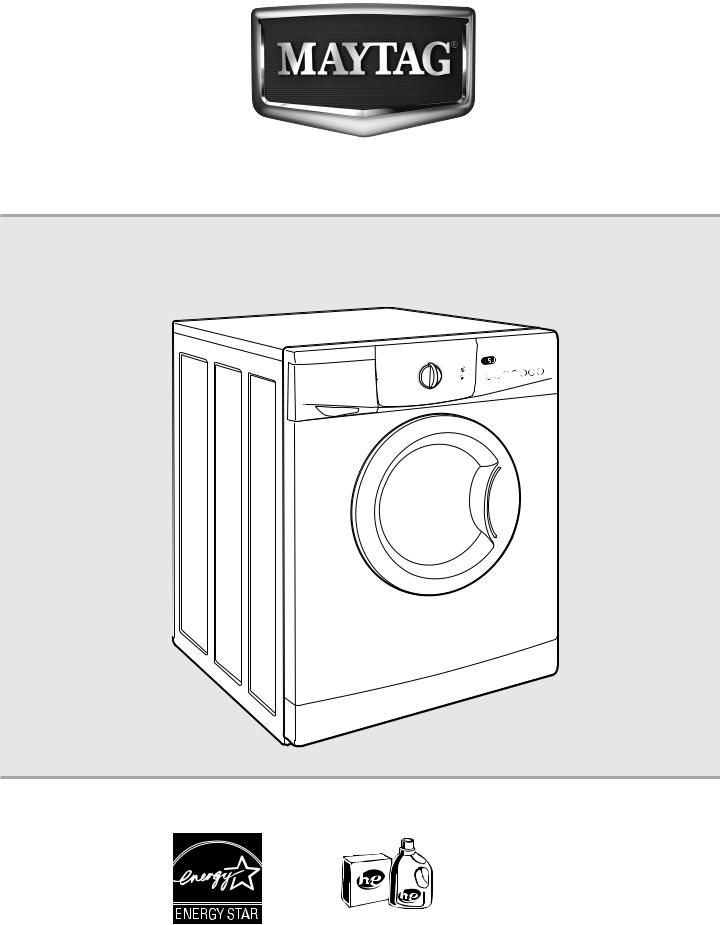
Use & Care Guide
Guide d’utilisation et d’entretien
FRONT-LOADING AUTOMATIC WASHER
LAVEUSE AUTOMATIQUE À CHARGEMENT FRONTAL
Para obtener acceso
al Manual de uso y cuidado en español, o para obtener información adicional acerca de su producto, visite: www.maytag.com
If you have any problems or questions, visit us at www.maytag.com
Pour tout problème ou question, consulter www.maytag.ca
Designed to use only HE High Efficiency detergents.
Conçue pour l’utilisation d’un détergent haute efficacité seulement.
W10445545B W10445548A - SP
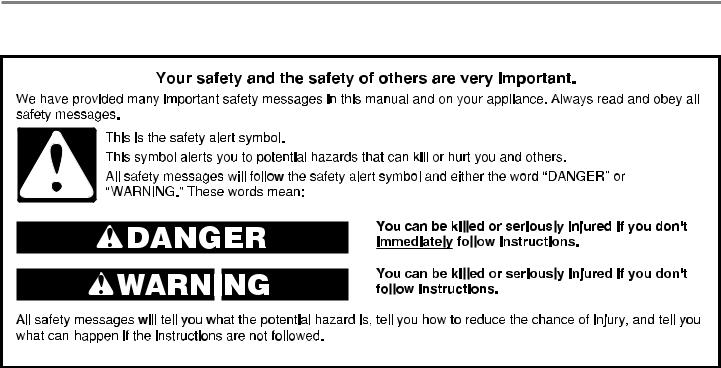
FRONT-LOADING AUTOMATIC WASHER
TABLE OF CONTENTS
WASHER SAFETY.......................................................... |
2 |
OPERATING INSTRUCTIONS....................................... |
4 |
FEATURES AND BENEFITS............................................... |
4 |
CONTROL PANEL AND FEATURES.................................. |
5 |
CYCLE GUIDE................................................................... |
7 |
USING YOUR WASHER.................................................... |
8 |
WASHER MAINTENANCE............................................... |
11 |
INSTALLATION INSTRUCTIONS................................ |
14 |
INSTALLATION REQUIREMENTS.................................... |
14 |
LOCATION REQUIREMENTS.......................................... |
15 |
DRAIN SYSTEM............................................................... |
16 |
ELECTRICAL REQUIREMENTS....................................... |
17 |
INSTALLATION INSTRUCTIONS..................................... |
17 |
ROUTE DRAIN HOSE...................................................... |
18 |
CONNECT INLET HOSES................................................ |
19 |
LEVEL WASHER.............................................................. |
20 |
COMPLETE INSTALLATION CHECKLIST........................ |
21 |
TROUBLESHOOTING.................................................. |
22 |
ACCESSORIES............................................................ |
28 |
WARRANTY................................................................. |
29 |
ASSISTANCE OR SERVICE......................... |
Back Cover |
LAVEUSE AUTOMATIQUE À CHARGEMENT FRONTAL
TABLE DES MATIÈRES
SÉCURITÉ DE LA LAVEUSE....................................... |
30 |
INSTRUCTIONS D’UTILISATION................................ |
31 |
CARACTÉRISTIQUES ET AVANTAGES........................... |
31 |
TABLEAU DE COMMANDE ET CARACTÉRISTIQUES.... |
32 |
GUIDE DES PROGRAMMES........................................... |
34 |
UTILISATION DE LA LAVEUSE........................................ |
36 |
ENTRETIEN DE LA LAVEUSE.......................................... |
40 |
INSTRUCTIONS D’INSTALLATION............................. |
43 |
EXIGENCES D’INSTALLATION........................................ |
43 |
EXIGENCES D’EMPLACEMENT...................................... |
44 |
SYSTÈME DE VIDANGE.................................................. |
45 |
SPÉCIFICATIONS ÉLECTRIQUES................................... |
46 |
INSTRUCTIONS D’INSTALLATION |
.................................. |
47 |
ACHEMINER LE TUYAU D’ÉVACUATION....................... |
48 |
|
RACCORDEMENT DES TUYAUX |
|
|
D’ARRIVÉE D’EAU........................................................... |
|
49 |
ÉTABLISSEMENT DE L’APLOMB DE ........LA LAVEUSE |
50 |
|
LISTE DE VÉRIFICATION POUR L’ACHÈVEMENT |
|
|
DE L’INSTALLATION........................................................ |
|
51 |
DÉPANNAGE................................................................ |
|
52 |
ACCESSOIRES............................................................ |
|
60 |
GARANTIE.................................................................... |
|
63 |
ASSISTANCE |
|
|
OU SERVICE.................................... |
Couverture arrière |
|
WASHER SAFETY
2
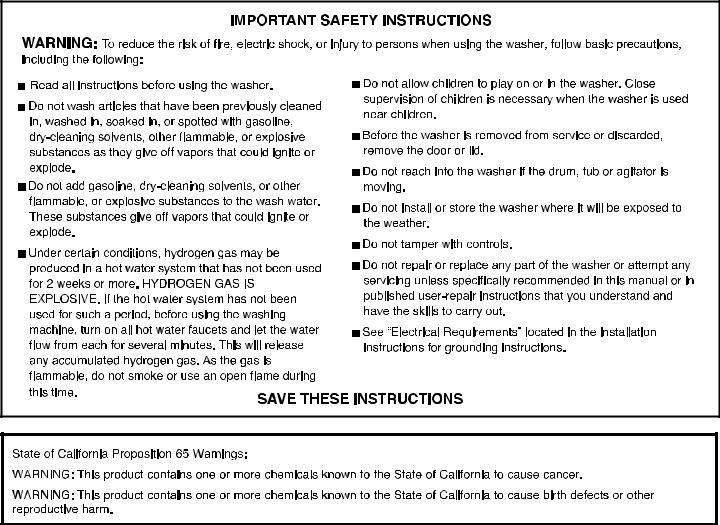
3

OPERATING INSTRUCTIONS
1 |
2 |
3 |
4 |
5 |
6 |
7 |
|
FEATURES AND BENEFITS
Your new front-loading high efficiency washer, was designed to conserve resources and lower your water and energy bills. The washer is designed to determine and then provide the amount of water needed for the best performance. The time of operation may be greater for this new system than for a conventional washer.
1ELECTRONIC CONTROLS
Flexible electronic controls are easy to use whether you are a beginner or an expert.
2AUTO TEMP CONTROL
ATC (Auto Temp Control) electronically senses and
maintains a uniform water temperature. ATC regulates incoming hot and cold water. The ATC is automatically turned ON when a cycle is selected. See “Cycle Guide.”
νATC works for the wash temperature with Warm and Cold settings.
νThe cold rinse temperatures depend on the cold water at your faucet.
3AUTO WATER LEVEL
Adjusting to the size of the load, this feature allows the washer to use the minimal amount of water needed to clean and rinse the clothes. With a low water level, you can obtain the same results with smaller amounts of laundry products. Because only the required amount of water is used, the washer saves energy, too.
4STAINLESS STEEL DRUM
The stainless steel drum eliminates corrosion and enables higher spin speeds for more water extraction, reducing drying time.
5SUSPENSION SYSTEM
To reduce washer “walk” and “off-balance” conditions, your new washer combines:
ν2 Springs to isolate vibration
ν2 Shock absorbers at the washer base to minimize movement
6DYNAMIC BALANCE
A precision balancing system allows the washer to reach high-speed spins. The washer spins faster so that clothes coming out of the washer will have less moisture than with traditional top load washers. In addition, if the Dynamic Balance system detects off-balance loads during spinning, it redistributes the clothes so that they are evenly balanced.
7ADAPTIVE VARIABLE SPEED MOTOR
The motor adapts to the load size and to the cycle
selected to give the optimum cleaning, rinsing, and spinning conditions. The motor can handle slow speeds needed for delicate items and is powerful enough to drive an average clothes load up to high-speed spin.
4
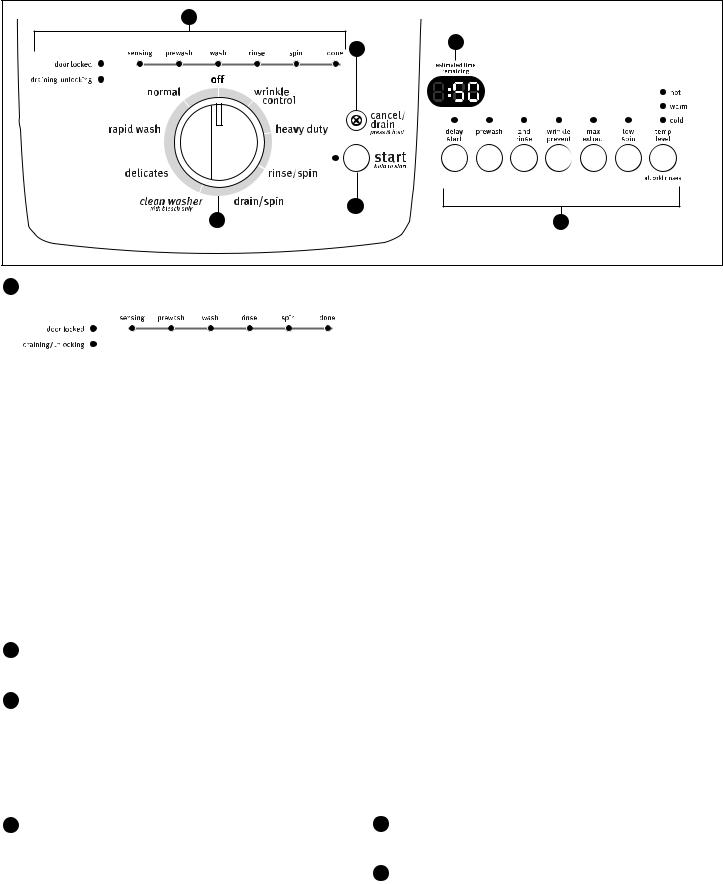
CONTROL PANEL AND FEATURES
1 |
|
|
|
2 |
3 |
|
|
|
|
5 |
|
6 |
|
4 |
1CYCLE STATUS LIGHTS
The Cycle Status Lights show the progress of a cycle. At each stage of the process, you may notice sounds or pauses that are different from traditional washers.
The Sensing status light comes on as the washer automatically weighs items, then adjusts the Estimated Time Remaining, based on the cycle selected.
When the Door Locked LED light illuminates, the door
is locked. The door is locked and unlocked automatically, depending on the stage of the wash cycle. Press and hold CANCEL/DRAIN for 3 seconds to unlock the door manually. It will take approximately 1 minute for the door
to unlock. When the door is unlocked, the Draining/Unlocking light illuminates.
The Prewash, Wash, Rinse, and Spin lights each come on as the washer progresses through each cycle.
The Done status light stays on for 1 hour after the cycle is complete. To power down the washer manually after the wash cycle is complete, switch knob to the Off position.
2CANCEL/DRAIN BUTTON
Press to turn the washer on and off. Press to stop/cancel a cycle at any time.
3ESTIMATED TIME REMAINING
The cycle times vary automatically based on your water pressure, water temperature, detergent, and clothes load. The cycle time will be extended if oversudsing occurs or the load is unbalanced. The oversuds routine removes extra suds and ensures proper rinsing of your garments. The options you select will also affect the cycle times that are shown in the “Cycle Guide.” The Estimated Time Remaining can change to much longer times under extreme conditions.
4OPTIONS
You can customize your wash by adding options to your cycle selections. Not all options are available with all cycles.
νIf an option is available with a selected cycle, the light for that option will illuminate when selected.
νIf an option is unavailable with a selected cycle, there will be a blinking light. The light for that option will not illuminate when selected.
Delay Start
Use this to begin the wash cycle later.
νSelect DELAY START until the desired time (in hours) shows in the Estimated Time Remaining display.
νSelect START. The countdown to the wash cycle will show in the display window.
Prewash
Prewash is an 18-minute soak phase that is added before the main wash. During prewash, there is only a small amount of tumbling.
2nd Rinse
A second rinse can be used to aid in the removal of detergent or bleach residue from garments. This
option provides an additional rinse with the same water temperature as in the normal rinse. You may select or deselect by pressing 2ND RINSE.
Wrinkle Prevent
Use this option to increase the quantity of incoming water and decrease the spin speed and duration in the rinse period. The last spin phase will have a lower spin speed and last a shorter time.
Max Extract
Use this option to increase the final spin period by 1 minute during the final spin.
Low Spin
Each cycle has a preset spin speed. To reduce the final spin speed, press the LOW SPIN button.
Temp Level
Each cycle has a preset water temperature setting. To change the water temperature, press the TEMP LEVEL button until the desired setting is illuminated.
Select a water temperature based on the type of load you are washing. Use the warmest wash water safe for fabrics. Follow garment label instructions.
The water temperature for all rinse cycles is cold. Cold rinses save energy.
5START BUTTON
Press and hold to start a cycle, or press once while a cycle is in process to pause it.
6WASH CYCLE KNOB
Turn the Wash Cycle knob to select a cycle for your laundry load. See “Cycle Guide” for detailed descriptions of cycles that best suit your load.
5

CONTROL PANEL AND FEATURES (CONT.)
7
A
C D
A Dispenser release lever
B HE detergent compartment B
C Fabric softener
D Liquid chlorine bleach
7SMART DISPENSE DRAWER
The three compartments in the dispenser allow loading of all laundry products before the washer is started. The
products will be dispensed into the wash at the optimal time for high-performance cleaning. The bleach release system is included in the detergent advantage system. The detergent is added at the beginning of the cycle, and the bleach is added after the enzymes have had a chance to do their cleaning.
The fabric softener is dispensed in the rinse cycle or in the 2ND RINSE, if selected. The Detergent Advantage System Dispenser tray is easily removed for cleaning.
ADispenser Release Lever
BHigh Efficiency “HE” detergent compartment
Add liquid or powdered HE detergent to this compartment for your main wash cycle.
νPowdered color-safe bleach may be added to this compartment along with powdered HE detergent.
CLiquid chlorine bleach compartment
Automatically dilutes and dispenses liquid chlorine bleach at the optimum time during the first rinse after the wash cycle. This compartment cannot dilute powdered bleach.
DLiquid fabric softener compartment
Automatically dilutes and dispenses liquid fabric softener at the optimum time in the cycle.
νUse only liquid fabric softener in this dispenser.
Choosing the Right Detergent
Use only High Efficiency detergents. The package will be marked “HE” or “High Efficiency.” Low-water washing creates excessive sudsing with a non-HE detergent. Using non-HE detergent will likely result in longer cycle times and reduced rinsing performance. It may also result in component failure and, over time, build-up of mold or mildew. HE detergents are made to produce the right amount of suds for the best performance. Follow the manufacturer’s instructions to determine the amount of detergent to use.
Use only High Efficiency (HE) detergent.
6

CYCLE GUIDE
Choose Wash Cycles by rotating the Cycle Selector Knob to the desired cycle. Each cycle is designed for different types of fabric and soil levels.
νEach cycle has a default cycle time and temperature level, and may have preset options. The preset settings provide the recommended fabric care for the selected cycle.
νThe preset settings can be changed anytime before START is pressed. Not all options and modifiers (temperature level, spin options) are available with all cycles. Press and hold START (for approximately 3 seconds) to continue the cycle.
Items to wash: |
Cycle: |
Estimated |
Temp. |
Spin |
Available |
Cycle Details: |
|
|
Time* (hr:min): |
Level†: |
Speed: |
Options: |
|
Normally soiled cotton |
Normal |
0:50 |
Warm |
High |
Delay Start |
Use this cycle to wash loads of normally |
and linens |
|
|
|
|
Prewash |
soiled cottons and linens. This cycle has |
|
|
|
|
|
2nd Rinse1 |
high-speed spin. |
|
|
|
|
|
Max Extract |
|
|
|
|
|
|
Low Spin |
|
Small loads of 2–3 |
Rapid |
0:30 |
Warm |
High |
Delay Start |
Use this cycle to wash small loads of 2–3 |
lightly soiled cotton, |
Wash |
|
|
|
Prewash |
lightly soiled garments that are needed |
polyester, nylon and |
|
|
|
|
2nd Rinse1 |
in a hurry. This cycle combines a |
cotton blends |
|
|
|
|
Wrinkle Prevent1 |
shortened wash time and high-speed |
|
|
|
|
|
Max Extract |
spin to shorten drying time. Large wash |
|
|
|
|
|
Low Spin |
loads will result in the washer increasing |
|
|
|
|
|
|
the wash time. |
Curtains and delicate |
Delicates |
0:37 |
Warm |
Low |
Delay Start |
Use this cycle to wash sheer fabrics and |
clothing, dresses, |
|
|
|
|
Prewash |
lingerie. This cycle has low-speed spin for |
skirts, shirts and |
|
|
|
|
2nd Rinse1 |
gentle fabric care. Use mesh garment |
blouses |
|
|
|
|
Wrinkle Prevent1 |
bags to wash undergarments such as |
|
|
|
|
|
Low Spin |
underwire bras, items with strings, and |
|
|
|
|
|
|
small items such as socks. |
No clothes, use |
Clean |
1:15 |
Hot |
High |
Delay Start |
Use the Clean Washer cycle once |
affresh® Washer |
Washer |
|
|
|
|
a month to keep the inside of your washer |
Cleaner or chlorine |
|
|
|
|
|
fresh and clean. This cycle uses a higher |
bleach |
|
|
|
|
|
water level. Use with affresh® Washer |
|
|
|
|
|
|
Cleaner tablet or liquid chlorine bleach to |
|
|
|
|
|
|
thoroughly clean the inside of your washer. |
|
|
|
|
|
|
This cycle should not be interrupted. |
|
|
|
|
|
|
See “Washer Care.” |
|
|
|
|
|
|
IMPORTANT: Do not place garments |
|
|
|
|
|
|
or other items in the washer during the |
|
|
|
|
|
|
Clean Washer cycle. Use this cycle with |
|
|
|
|
|
|
an empty wash drum. |
|
|
|
|
|
|
|
All loads |
Drain/ |
0:18 |
N/A |
High |
Delay Start |
Use this cycle to drain your washer |
|
Spin |
|
|
|
Max Extract |
or to drain and spin your wash load. |
|
|
|
|
|
Low Spin |
The spin speed is preset to HIGH. |
All loads |
Rinse/ |
0:24 |
Cold |
High |
Delay Start |
Use this cycle to get a rinse and spin only. |
|
Spin |
|
|
|
2nd Rinse1 |
This cycle has high-speed spin. |
|
|
|
|
|
Max Extract |
Rinse/Spin is useful for loads that need |
|
|
|
|
|
Low Spin |
rinsing only and for adding fabric softener |
|
|
|
|
|
|
to a load using the fabric softener |
|
|
|
|
|
|
dispenser. |
Heavily soiled |
Heavy Duty |
1:10 |
Warm |
High |
Delay Start |
Use this cycle to wash loads of sturdy, |
underwear, towels, |
|
|
|
|
Prewash |
colorfast fabrics and heavy soiled |
shirts, etc., made of |
|
|
|
|
2nd Rinse1 |
garments. This cycle combines |
cotton |
|
|
|
|
Max Extract |
a longer wash time and high-speed spin |
|
|
|
|
|
Low Spin |
to shorten drying times. |
Normally soiled |
Wrinkle |
0:45 |
Warm |
Low |
Delay Start |
Use this cycle to wash loads of |
permanent press |
Control |
|
|
|
Prewash |
permanent press blends and synthetic |
blends and synthetic |
|
|
|
|
2nd Rinse1 |
fabrics. This cycle has a load cooling |
fabrics |
|
|
|
|
Wrinkle Prevent1 |
process to reduce wrinkling. |
|
|
|
|
|
Max Extract |
|
|
|
|
|
|
Low Spin |
|
|
|
|
|
|
|
|
*The cycle times vary automatically based on your water pressure, water temperature, detergent, and clothes load. The cycle time will be extended if oversudsing occurs or the load is unbalanced.
† All rinses are cold.
1 You cannot select 2nd Rinse and Wrinkle Prevent for the same load.
7

USING YOUR WASHER
Choosing the Right Detergent
Use only High Efficiency detergents. The package will be marked “HE” or “High Efficiency.” Low-water washing creates excessive sudsing with a non-HE detergent. Using non-HE detergent will likely result in longer cycle times and reduced rinsing performance. It may also result in component failure and, over time, build-up of mold or mildew. HE detergents are made to produce the right amount of suds for the best performance. Follow the manufacturer’s instructions to determine the amount of detergent to use.
Use only High Efficiency (HE) detergent.
First wash cycle without laundry
Before washing clothes for the first time, fill the HE liquid dispenser cartridge and install in the dispenser drawer. Choose the RAPID WASH cycle and run it without clothes. Use only HE detergent. This initial cycle serves to ensure the interior is clean and the dispenser drawer is ready for use before washing clothes.
IMPORTANT:
νEmpty pockets. Loose change, buttons, or any small object can plug pumps and may require a service call.
νClose zippers, fasten hooks, tie strings and sashes, and remove non-washable trim and ornaments.
νMend rips and tears to avoid further damage to items during washing.
νTurn knits inside out to prevent pilling. Separate lint-takers from lint-givers. Synthetics, knits, and corduroy fabrics will pick up lint from towels, rugs, and chenille fabrics.
νDo not dry garments if stains remain after washing, because heat can set stains into fabric.
νAlways read and follow fabric care labels and laundry product instructions. Improper usage may cause damage to your garments.
2.Load laundry into washer
1. Sort and prepare your laundry
Sort items by recommended cycle, water temperature, and colorfastness. Separate heavily soiled items from lightly soiled. Separate delicate items from sturdy fabrics. Treat stains promptly and check for colorfastness by testing stain remover products on an inside seam.
8
Open the washer door. Place a load of sorted clothes loosely in the washer. Items need to move freely for best cleaning and to reduce wrinkling and tangling. Close the washer door by pushing it firmly until the latch clicks.
NOTE: There is a routine at the beginning of each cycle to avoid unintended use of the washer. This routine will take approximately 1 minute to complete before the selected wash cycle begins.
νDepending on load type and cycle, the washer can be fully loaded, but not tightly packed. Washer door should close easily. See “Cycle Guide” for loading suggestions.
νMix large and small items and avoid washing single items. Load evenly.
νWash small items in mesh garment bags. For multiple items, use more than one bag and fill bags equally.
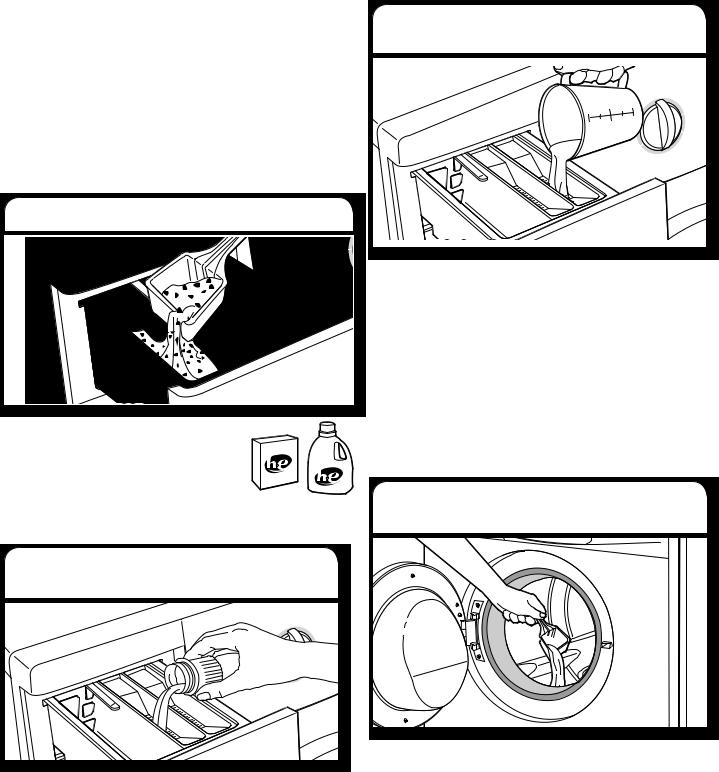
Using the Dispense Drawer
To use the dispenser drawer:
1.Open the dispenser drawer.
2.Add laundry products as described in steps 3–6.
3.Slowly close the dispenser drawer. Make sure it is completely closed.
NOTES:
νA small amount of water may remain in the dispensers from the previous wash cycle. This is normal.
νSee “About Detergent Concentration” for information on detergent concentration.
3.Add HE detergent to dispenser
5. Add liquid chlorine bleach to dispenser (if desired)
Add liquid or powdered HE detergent to this compartment for your main wash cycle.
ν Powdered color-safe bleach may be added to the Main Wash compartment along with the powdered detergent.
ν Follow the manufacturer’s instructions to |
Use only High Efficiency |
determine the amount of detergent to use. |
(HE) detergent. |
NOTE: Overfilling could cause an oversudsing condition.
4. Add fabric softener to dispenser (if desired)
Pour a measured amount of liquid fabric softener into liquid fabric softener compartment. Always follow manufacturer’s directions for correct amount of fabric softener based on your load size.
Fabric softener will be automatically dispensed in the final rinse or in the 2ND RINSE, if selected.
IMPORTANT: Do not overfill, dilute, or use more than 1/2 cup (120 mL) of fabric softener. Do not fill past the MAX line. Overfilling dispenser will cause fabric softener to immediately dispense into washer.
νDo not spill or drip any fabric softener onto the clothes.
νDo not use liquid fabric softener dispenser balls in this washer. They will not dispense correctly.
νDo not fill beyond the “MAX” level.
Add liquid chlorine bleach to the bleach compartment. Do not overfill, dilute, or use more than 1/2 cup (120 mL). Do not use color-safe bleach or Oxi in the same cycle with
liquid chlorine bleach. The bleach will be automatically diluted and dispensed at the best time during the first rinse after the wash cycle.
νAlways measure liquid chlorine bleach. Use a measuring cup with a pour spout; do not guess.
νDo not fill beyond the “MAX” level. Overfilling could cause garment damage.
νDo not add color-safe bleach or oxi-product to this dispenser. Add Oxi product or color-safe bleach to the drum before loading clothes. Follow garment wash label care instructions.
6.Add Oxi or color safe bleach (if desired)
Oxi-type boosters or color-safe bleach can be added to the drum prior to adding laundry.
9
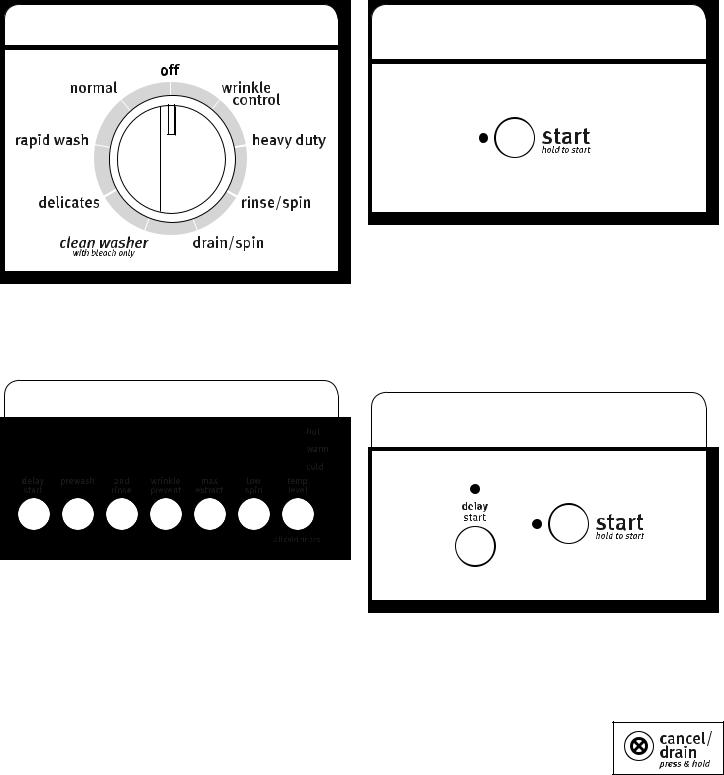
USING YOUR WASHER (CONT.)
7. Turn Cycle Selector to start washer
9. Press and hold START to begin wash cycle immediately
Turn on the washer by turning the Cycle Selector and selecting one of the cycles. The indicator light for the selected cycle will illuminate. When selecting a Wash Cycle, the preset modifiers, options and temperature level for the selected cycle will illuminate. The preset settings provide the recommended fabric care for the selected cycle. See “Cycle Guide.”
Press and hold START (for approximately 3 seconds).
νIf you do not press START within 5 minutes of choosing a cycle, the washer display automatically shuts off.
νWhen the wash cycle is complete, the DONE status light illuminates, the door unlocks and the wash load can be removed from the washer. The washer goes into standby mode automatically after the door is opened or 1 hour after the cycle is complete and all displays will go off.
νTo power down the washer manually after the wash cycle is complete, switch knob to Off position.
|
8. Select desired options |
|
|
|
|
|
10. Press DELAY START and START |
||
|
|
|
|
|
|
|
|
|
to begin wash cycle later |
|
|
|
|
|
|
|
|
|
|
|
|
|
|
|
Not all options are available with all cycles. See “Control Panel and Features.”
Cycles and options can be changed anytime before START is pressed.
Once you select a cycle, select the desired temperature level.
NOTE: Always follow fabric care label instructions to avoid damage to your garments.
Wash Temp |
Suggested Fabrics |
|
|
|
|
Hot |
|
|
Some cold water is added to save |
Whites and pastels |
|
energy. This will be cooler than |
Durable garments |
|
your hot water heater setting. |
||
Heavy soils |
||
|
||
|
|
|
Warm |
|
|
Some cold water will be added, so |
Bright colors |
|
this will be cooler than what your |
Moderate to light soils |
|
previous washer provided. |
||
|
||
|
|
|
Cold |
Dark colors that |
|
Warm water may be added to |
||
assist in soil removal and to help |
bleed or fade |
|
dissolve detergents. |
Light soils |
|
|
|
Press DELAY START until the desired delay time (in hours) is displayed. Select START. The countdown to the wash cycle will show in the display window.
IMPORTANT: When delaying a cycle, use only powdered detergents in the main wash compartment since liquid detergents may seep out of the compartment during the delay before the wash cycle begins.
To restart the washer at any time, press and hold CANCEL/DRAIN.
10

WASHER MAINTENANCE
WASHER CARE
Recommendations to Help Keep Your Washer Clean and Performing at its Best
1.Always use High Efficiency (HE) detergents and follow the HE detergent manufacturer’s instructions regarding the amount of HE detergent to use. Never use more than the recommended amount because that may increase the rate at which detergent and soil residue accumulate inside your washer, which in turn may result in undesirable odor.
2.Use warm or hot water washes sometimes (not exclusively cold water washes), because they do a better job of controlling the rate at which soils and detergent accumulate.
3.Always leave the washer door slightly ajar between uses to help dry out the washer and prevent the buildup of odor-causing residue.
Cleaning Your Front Loading Washer
Read these instructions completely before beginning the routine cleaning processes recommended below. This Washer Maintenance Procedure should be performed, at a minimum, once per month or every 30 wash cycles,
whichever occurs sooner, to control the rate at which soils and detergent may otherwise accumulate in your washer.
Cleaning the Door Seal
1.Open the washer door and remove any clothing or items from the washer.
2.Inspect the gray colored seal between the door opening and the drum for stained areas or soil buildup. Pull back the seal to inspect all areas under the seal and to check for foreign objects.
3.If stained areas or soil buildup are found, wipe down these areas of the seal using either of the following two procedures:
a.Affresh® Grit Grabber™ Cloth Procedure:
i.When the cycle is complete, gently pull back the rubber door seal and clean the entire surface with the rough side of the Grit Grabber™ cloth.
b.Dilute Liquid Chlorine Bleach Procedure:
i.Mix a dilute bleach solution, using 3/4 cup (177 mL) of liquid chlorine bleach and 1 gallon (3.8 L) of warm tap water.
ii.Wipe the seal area with the dilute solution, using a damp cloth.
iii.Let stand 5 minutes.
iv.Wipe down area thoroughly with a dry cloth and let washer interior air dry with door open.
IMPORTANT:
νWear rubber gloves when cleaning with bleach.
νRefer to the bleach manufacturer’s instructions for proper use.
WASHER CARE (cont.)
Cleaning the Inside of the Washer
This washer has a special cycle that uses higher water volumes in combination with affresh® Washer Cleaner or liquid chlorine bleach to thoroughly clean the inside of the washer. Steam washer models also utilize steam to enhance cleaning in this special cycle.
NOTE: Read these instructions completely before beginning the cleaning process.
Begin procedure
1.Affresh® Washer Cleaner Cycle Procedure (Recommended):
a.Open the washer door and remove any clothing or items.
b.Add an affresh® Washer Cleaner tablet to the washer drum.
c.Do not add the affresh® Washer Cleaner tablet to the dispenser drawer.
d.Do not add any detergent or other chemical to the washer when following this procedure.
e.Close the washer door.
f.Select the CLEAN WASHER cycle.
g.Press the START button to begin the cycle. The Clean Washer Cycle Operation is described below.
2.Chlorine Bleach Procedure:
a.Open the washer door and remove any clothing or items.
b.Open the dispenser drawer and add 2/3 cup (160 mL) of liquid chlorine bleach to the bleach compartment.
NOTE: Use of more liquid chlorine bleach than is recommended above could cause product damage over time.
c.Close the washer door and the dispenser drawer.
d.Do not add any detergent or other chemical to the washer when following this procedure.
e.Close the washer door.
f.Select the CLEAN WASHER cycle.
g.Press the START button to begin the cycle. The Clean Washer Cycle Operation is described below.
Description of Clean Washer Cycle Operation:
1.The Clean Washer cycle will determine whether clothing or other items are in the washer.
2.If no items are detected in the washer, it will proceed to step 3.
a.If any items are detected in the washer, “rL” (remove load) will be displayed, and the washer “Controls Lock” lights will remain lit. The door will unlock. Open washer and remove any garments from the washer drum.
b.Press “CANCEL/DRAIN” to clear the “rL” code.
c.Press “START” to restart the cycle.
3.After the cycle is complete, leave the door open slightly to allow for better ventilation and drying of the washer interior.
Cancellation of Clean Washer Cycle Operation:
If the Clean Washer cycle is canceled by the user after it has been initiated, it may take up to 30 minutes for the washer to purge any affresh® cleaner, chlorine bleach, or other chemistry from the wash system and to adequately rinse any
remaining chemistry. The washer door will remain locked until the cancellation process has been completed. This ensures no cleaning chemistry will be carried over to the next wash cycle and reduces the potential for damage to subsequent loads of laundry or to the washer itself.
11

WASHER MAINTENANCE
WASHER CARE (cont.)
Clean Washer Cycle Cancellation Procedure:
1.Press the “CANCEL/DRAIN” button on the washer two times.
2.Washer will begin to drain and rinse away the remaining cleaning chemistry.
3.The cycle will complete the cancellation process in approximately 30 minutes or less.
4.The washer then can be used to either repeat the Clean Washer cycle or to wash laundry using one of the regular wash cycles selected by the user.
Cleaning the Outside of the Washer
Use a soft, damp cloth or sponge to wipe up any spills. Occasionally wipe the outside of your washer to help keep it looking new.
IMPORTANT: To avoid damaging the washer’s finish, do not use abrasive products.
WASHER CARE (cont.)
Removing the Dispenser
To remove:
1.Unlock the dispenser drawer by pressing the Dispenser Release Lever (see “Control Panel and Features”). Remove the drawer.
2.Remove the inserts (the siphon from the softener and bleach
compartments).
3. You may find laundry product residue leftover in your dispenser compartments. To remove residue, wash the parts under running water.
NOTE: Do not wash components in the dishwasher.
WASHER CARE (cont.)
To replace:
Replace the inserts and return the dispenser to the drawer.
12

WASHER MAINTENANCE
NON-USE AND VACATION CARE
Operate your washer only when you are home. If moving, or not using your washer for a period of time, follow these steps:
1.Unplug or disconnect power to washer.
2.Turn off water supply to washer to avoid flooding due to water pressure surges.
3.Clean the dispenser. See “Washer Care.”
WINTER STORAGE CARE
IMPORTANT: To avoid damage, install and store washer where it will not freeze. Because some water may stay in hoses, freezing can damage washer. If storing or moving during freezing weather, winterize your washer.
To winterize washer:
1.Shut off both water faucets, disconnect and drain water inlet hoses.
2.Put 1 qt. (1 L) of R.V.-type antifreeze in basket and run washer on Drain/Spin cycle for about 1 minute to mix antifreeze and remaining water.
3.Unplug washer or disconnect power.
IMPORTANT: To reduce risk of hose failure, replace inlet hoses every five years and periodically inspect for kinks, cuts, wear or water leaks.
HELPFUL TIP: When replacing your inlet hoses, mark replacement date on label with a permanent marker.
TRANSPORTING YOUR WASHER
1.Shut off both water faucets. Disconnect and drain water inlet hoses. Clip hoses to rear panel of washer.
2.If washer will be moved during freezing weather, follow WINTER STORAGE CARE directions before moving.
3.Disconnect drain hose from drain system and attach to rear panel clips.
4.Unplug power cord.
5.Place inlet hoses and drain hose inside washer basket.
6.Bundle power cord with a rubber band or cable tie to keep it from hanging onto the ground.
IMPORTANT: Call for service to install new transport bolts. Do not reuse transport bolts. Washer must be transported in the upright position. To avoid structural damage to
your washer, it must be properly set up for relocation by a certified technician.
REINSTALLING/USING WASHER AGAIN
To reinstall washer after non-use, vacation, winter storage, or moving:
1.Refer to “Installation Instructions” to locate, level, and connect washer.
2.Before using again, run washer through the following recommended procedure:
To use washer again:
1.Flush water pipes and hoses. Reconnect water inlet hoses. Turn on both water faucets.
2.Plug in washer or reconnect power.
3.Run washer through Normal cycle to clean washer and remove antifreeze, if used. Use only HE detergent. Use half the manufacturer’s recommended amount for a medium-size load.
13

INSTALLATION
INSTRUCTIONS
INSTALLATION REQUIREMENTS
Tools and Parts
Gather required tools and parts before starting installation.
Tools needed:
|
|
|
|
|
|
|
|
|
Adjustable or open end |
|
Level |
||||||
wrenches 15/32" (12 mm) |
|
|
|
|
|
|
||
and 1/2" (13 mm) |
|
|
|
|
|
|
||
|
|
|
|
|
|
|
|
|
4" min |
|
|
|
|
|
|
|
|
(102 mm) |
|
|
|
|
|
|
|
|
|
|
|
|
|
|
|
||
|
|
|
|
|
|
|
|
|
|
|
|
|
|
|
|
|
|
|
|
|
|
|
|
|
|
|
Wood block |
Ruler or measuring tape |
|
|
|
|
Pliers that open to 19⁄16" (39.5 mm)
Parts supplied:
NOTE: All parts supplied for installation are in the washer basket.
|
|
|
Cable tie |
|
Inlet hoses (2) with |
|
|
washers |
|
|
|
|
|
|
U-shaped hose form |
Transport bolt hole |
|
plugs (4) |
Optional tools:
|
|
|
Flashlight |
|
Bucket |
Options:
Pedestal:
You have the option of purchasing a pedestal for this washer. You may select an 11.8" (300 mm) pedestal. The pedestal will add to the total height of the washer.
Pedestal |
Approximate |
Color |
Model |
Height |
Height with |
|
Number |
|
Washer |
|
|
11.8" (300 mm) |
44.7" (1135 mm) |
White |
LAB0050PQ |
|
|
|
|
Alternate parts: (Not supplied with washer)
Your installation may require additional parts. To order, please refer to toll-free numbers on the back page of this manual.
If you have: |
You will need: |
Laundry tub or standpipe |
Sump pump system (if not already |
taller than 55" (1.4 m) |
available) |
Overhead sewer |
Standard 20 gal. (76 L) 30" (762 mm) |
|
tall drain tub or utility sink, sump |
|
pump and connectors (available from |
|
local plumbing suppliers) |
Floor drain system |
Siphon Break Kit Part Number 285834 |
|
Connector Kit (x2) Part Number 285835 |
|
Additional Drain Hose Part |
|
Number 8318155 |
Drain hose too short |
Extension Drain Hose Part |
|
Number 285863 |
|
Connector Kit Part Number 285835 |
Water faucets beyond |
2 longer water fill hoses: |
reach of fill hoses |
6 ft (1.8 m) Part Number 76314 |
|
10 ft (3.0 m) Part Number 350008 |
Stack Kit:
Are you planning to stack your washer and dryer? To do so you will need to purchase a Stack Kit.
To order, call the dealer from whom you purchased your washer or refer to the “Assistance or Service” section. Ask for Part Number W10178021.
14
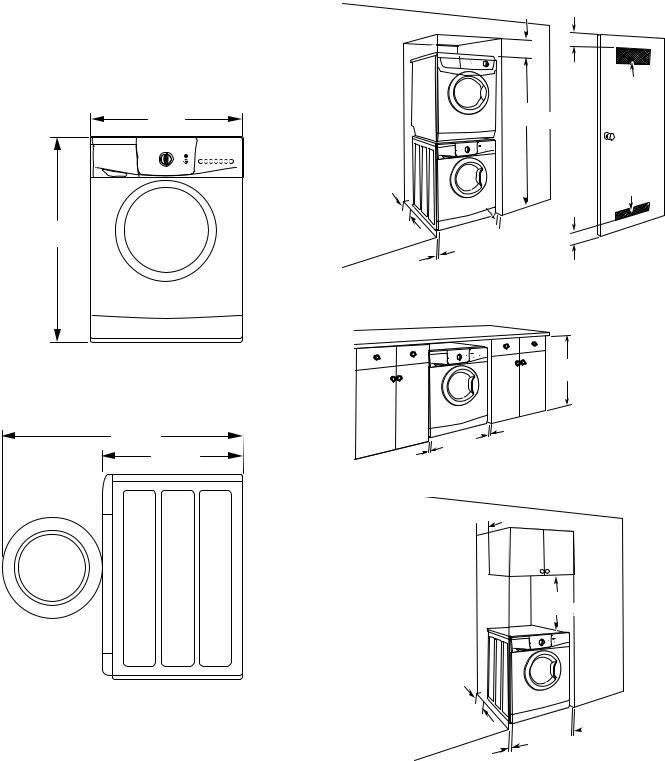
LOCATION REQUIREMENTS
Proper installation is your responsibility.
You will need:
νA water heater set to 120° F (49° C).
νA grounded electrical outlet located within 5.4 ft (1.7 m) of power cord on back of washer.
νHot and cold water faucets located within 4 ft (1.2 m) of hot and cold water fill valves on washer, and water pressure of 20–100 psi (137.9–689.6 kPa).
νA level floor with maximum slope of 1" (25 mm) under entire washer. Installing on carpet or surfaces with foam backing is not recommended.
νFloor must support washer’s total weight (with water and load) of 400 lbs (180 kgs).
IMPORTANT: Do not install, store or operate washer where it will be exposed to weather or in temperatures below 32° F
(0° C). Water remaining in washer after use may cause damage in low temperatures. See “Washer Maintenance” for winterizing information.
237/16"
(595 mm)
327/8"
(835 mm)
361/4""
(920 mm) 201/8"
(510 mm)
All dimensions show recommended spacing allowed, except for closet door ventilation openings which are the minimum required.
For each arrangement, consider allowing more space for ease of installation and servicing, and spacing for companion appliances and clearances for walls, doors, and floor moldings.
Space must be large enough to allow door to fully open. Add spacing of 1" (25 mm) on all sides of washer to reduce
noise transfer. If a closet door or louvered door is installed, top and bottom air openings in door are required.
Recessed area or closet installation (stacked washer and dryer):
12" (305 mm)
|
3" |
|
|
(76 mm) |
48 in.2 |
|
|
|
|
|
(310 cm2) |
|
653/4" |
|
|
(1670 mm) |
|
|
|
24 in.2 |
51/4" |
3" |
(155 cm2) |
(133 mm) |
|
|
(76 mm) |
|
|
|
|
 1"
1"
1" (25 mm) (25 mm)
*External exhaust elbow requires additional space.
Custom under counter installation:
39" min. (990 mm)
1" (25 mm)
Custom cabinet installation:
7" 
 (178 mm)
(178 mm)
9"

(229 mm)
4" (102 mm)
 1" 1"
1" 1"  (25 mm)
(25 mm)
(25 mm)
15
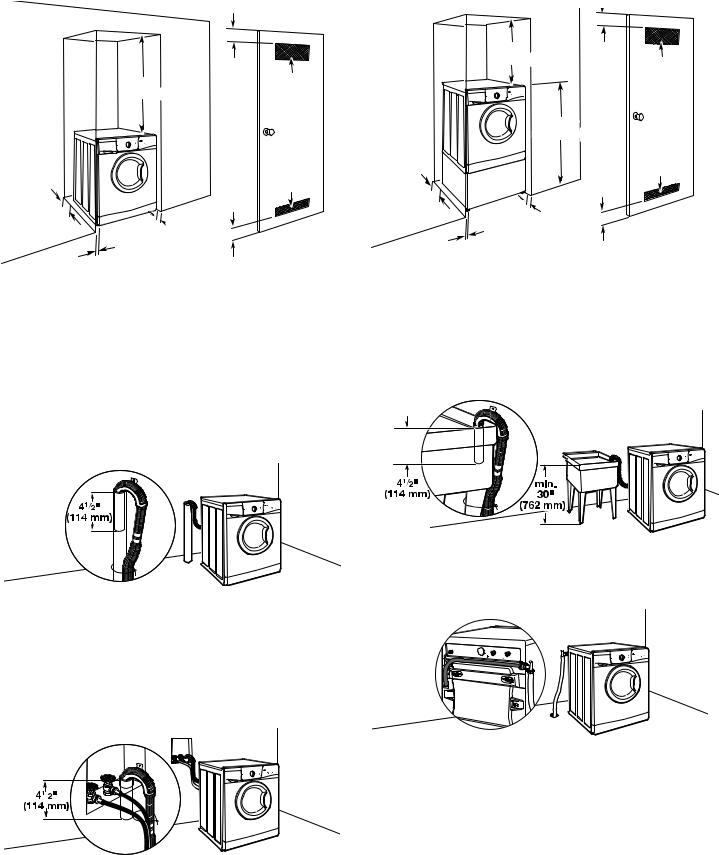
LOCATION REQUIREMENTS (cont.)
Recessed area or closet installation (washer only):
|
3" |
|
34"9 |
(76 mm) |
48 in.2 |
|
||
(229864 mm) |
|
(310 cm2) |
|
24 in.2 |
|
4" |
(155 cm2) |
|
3" |
||
(102 mm) |
||
(76 mm) |
||
|
 1" 1" (25 mm)
1" 1" (25 mm)
(25 mm)
DRAIN SYSTEM
Drain system can be installed using a floor drain, wall standpipe, floor standpipe, or laundry tub. Select method you need.
IMPORTANT: To avoid siphoning, only 41⁄2" (114 mm) of drain hose should be inside standpipe. Always secure drain hose with cable tie.
Floor standpipe drain system
Minimum diameter for a standpipe drain: 2" (51 mm). Minimum carry-away capacity: 17 gal. (64 L) per minute. A 1/4" (6 mm) diameter to 1" (25 mm) diameter Standpipe Adapter Kit is available (Part Number 3363920). Top of standpipe must be at least 30" (762 mm) high; install no higher than 55" (1.4 m) from bottom of washer. If you have an overhead sewer and need to pump higher than 96 inches, a sump pump and associated hardware are needed. See “Alternate Parts”.
Wall standpipe drain system
See requirements for floor standpipe drain system.
Recessed area or closet installation (washer on pedestal):
18"9 |
|
3" |
|
(457229 mm) |
(76 mm) |
48 in.2 |
|
|
|
|
|
|
|
|
(310 cm2) |
|
4411/16" |
|
|
|
(1135 mm) |
|
|
|
|
|
24 in.2 |
4" |
|
3" |
(155 cm2) |
(102 mm) |
|
|
|
|
(76 mm) |
|
|
|
|
|
|
|
1" |
|
|
1" |
(25 mm) |
|
|
|
|
|
|
(25 mm) |
|
|
|
Laundry tub drain system
Minimum capacity: 20 gal. (76 L). Top of laundry tub must be at least 30" (762 mm) above floor; install no higher than 55" (1.4 m) from bottom of washer.
Floor drain system
Floor drain system requires a Siphon Break Kit (Part Number 285834), 2 Connector Kits (Part Number 285835), and an Extension Drain Hose (Part Number 285863) that may be purchased separately. See “Alternate Parts”. Minimum siphon break height: 28" (710 mm) from bottom of washer. (Additional hoses may be needed.)
16
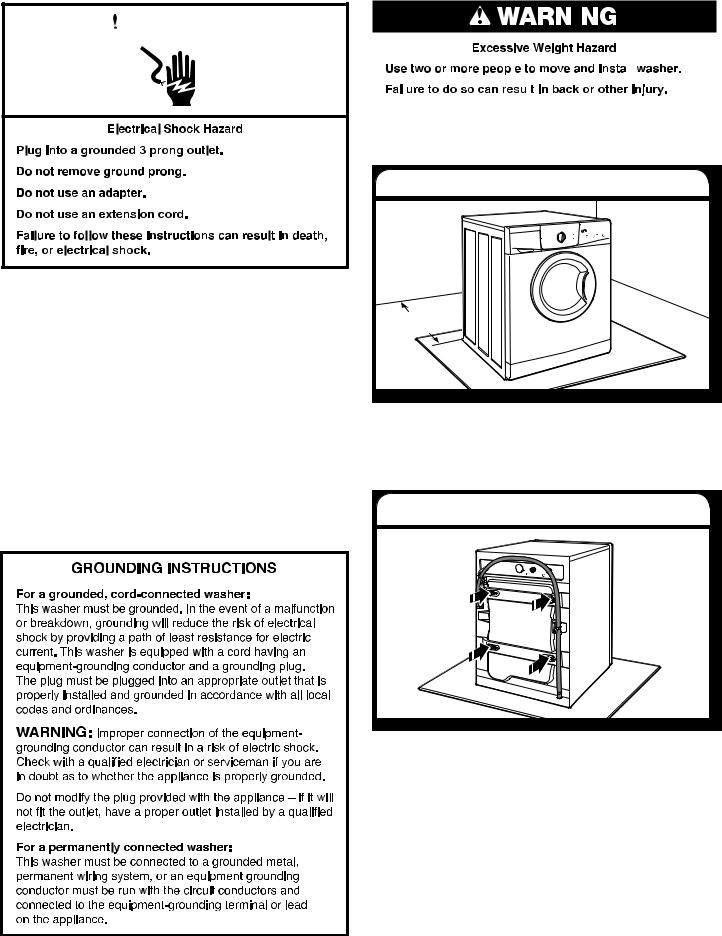
ELECTRICAL REQUIREMENTS |
INSTALLATION INSTRUCTIONS |
|||||||||||
|
|
|
|
|
|
|
|
|
|
|
|
|
|
|
|
|
|
|
|
|
|
|
|
|
|
|
|
|
|
|
|
|
|
|
|
|
|
|
|
|
|
|
|
|
|
|
|
|
|
|
|
|
|
|
|
|
|
|
|
|
|
|
|
|
|
|
|
|
|
|
|
|
|
|
|
|
|
|
|
|
|
|
|
|
|
|
|
|
|
|
|
|
|
|
|
|
|
|
|
|
|
|
|
|
|
|
|
|
|
|
|
|
|
|
|
|
|
|
|
|
|
|
|
|
|
|
|
|
|
|
|
|
|
|
|
|
|
|
|
|
|
|
νA 120 volt, 60 Hz., AC only, 15or 20-amp, fused electrical supply is required. A time-delay fuse or circuit breaker is recommended. It is recommended that a separate circuit breaker serving only this appliance be provided.
νThis washer is equipped with a power supply cord having a 3-prong grounding plug.
νTo minimize possible shock hazard, the cord must be plugged into a mating, 3-prong, grounding-type outlet, grounded in accordance with local codes and ordinances. If a mating outlet is not available, it is the personal responsibility and obligation of the customer to have the properly grounded outlet installed by a qualified electrician.
νIf codes permit and a separate ground wire is used, it is recommended that a qualified electrician determine that the ground path is adequate.
νDo not ground to a gas pipe.
νCheck with a qualified electrician if you are not sure the washer is properly grounded.
νDo not have a fuse in the neutral or ground circuit.
NOTE: To avoid floor damage, set washer onto cardboard before moving it.
1. Move washer
48" |
(1.2 m) |
It is necessary to remove all shipping materials for proper operation and to avoid excessive noise from washer.
Move washer to within 48" (1.2 m) of its final location. It must be in a fully upright position.
2. Locate transport bolts
Locate four transport bolts on rear of washer.
17
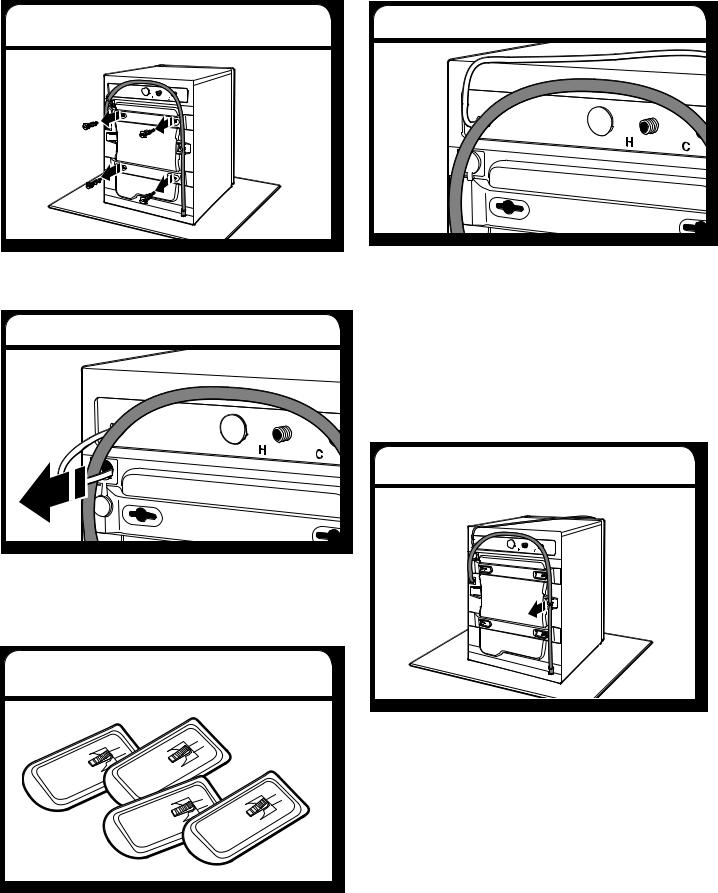
3. Remove transport bolts from |
6. Place power cord over top |
washer |
|
Loosen bolts with a 15/32" (12 mm) wrench. Once the bolt is loose, move it to the center of the hole and completely pull out the bolt, including the plastic spacer covering the bolt.
4. Remove power cord
Pull power cord through opening in rear panel.
NOTE: If washer is transported at later date, call your local service center to avoid suspension and structural damage, a certified technician must properly set up washer for relocation.
5. Cover bolt holes with transport bolt hole plugs
Close bolt holes on cabinet back with four transport bolt hole plugs included with washer parts.
Remove the yellow shipping strap from the cord. Gently place power cord over top of washer to allow free access to back of washer.
IMPORTANT: Do not plug washer in until installation has been completed.
ROUTE DRAIN HOSE
Proper routing of the drain hose protects your floor from damage due to water leakage. Read and follow these instructions.
7. Remove drain hose from washer
Gently pull the corrugated drain hose from the shipping clips.
18
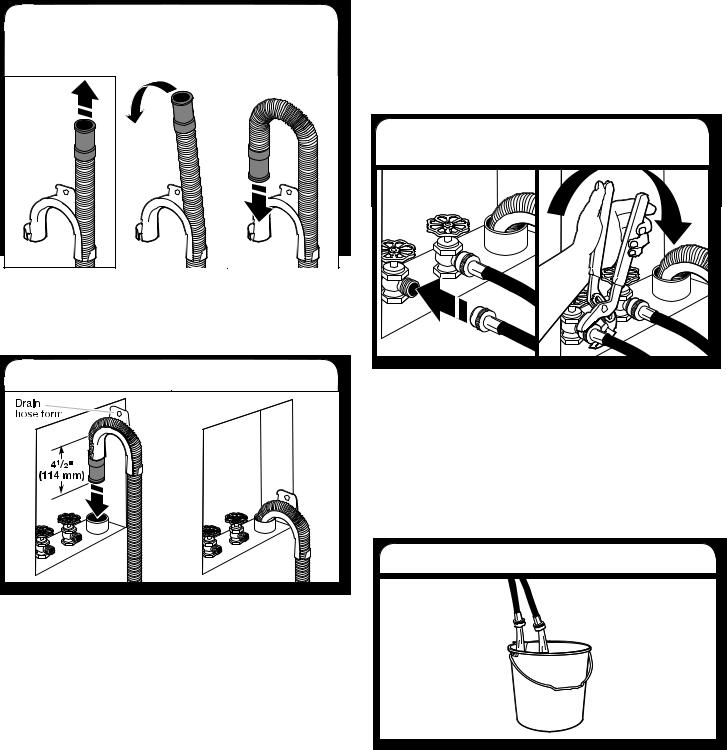
8. Connect laundry tub drain or standpipe drain hose form (floor drain installations only)
For floor drain installations, you will need to connect the drain hose form to the end of the drain hose. You may need
additional parts with separate directions. See “Alternate Parts”.
9. Place drain hose in standpipe
Place hose into standpipe (shown in picture) or over side of laundry tub.
IMPORTANT: Only 41⁄2" (114 mm) of drain hose should be inside standpipe; do not force excess hose into standpipe or lay on bottom of laundry tub. Drain hose form must be used.
CONNECT INLET HOSES
Washer must be connected to water faucets with new inlet hoses with flat washers. Do not use old hoses.
NOTE: Both hoses must be attached and have water flowing to inlet valves. For optimal performance, hot and cold water must be supplied to the washer.
10. Connect inlet hoses to water faucets
Attach hose to hot water faucet. Screw on coupling by hand until it is seated on washer. Use pliers to tighten couplings an additional two-thirds turn. Repeat this step with second hose for cold water faucet.
IMPORTANT: Do not overtighten or use tape or sealants on valve when attaching to faucets or washer. Damage can result.
HELPFUL TIP: Make note of which hose is connected to hot water to help in attaching hoses to washer correctly. In most standard configurations, hoses will cross over each other when attached correctly.
11. Clear water lines
Run water for a few seconds through hoses into a laundry tub, drainpipe, or bucket to avoid clogs. Water should run until clear.
19

12. Connect inlet hoses to washer |
LEVEL WASHER |
Leveling your washer properly reduces excess noise and |
|
|
vibration. |
15. Check levelness of washer
place level here
Attach hot water hose to hot water inlet valve. Screw coupling by hand until it is snug. Use pliers to tighten couplings an additional two-thirds turn. Repeat with cold water inlet valve.
IMPORTANT: To reduce risk of hose failure, replace the hoses every 5 years. Record hose installation or replacement dates for future reference.
νPeriodically inspect and replace hoses if bulges, kinks, cuts, wear, or leaks are found.
13.Check for leaks
Remove cardboard from beneath washer. Place a level on top edges of washer,
checking each side and front. If not level, tip washer and adjust feet up or down as shown in steps 17 and 18, repeating as necessary.
Not Level |
LEVEL |
Not Level |
16. Rock washer to test foot contact
Slowly turn on water faucets to check for leaks. A small amount of water may enter washer. It will drain later.
14. Secure drain hose |
|
|
|
Laundry Tub |
Standpipe |
Wall |
|
|
41/2" |
|
Grip washer from top and rock back and forth, making sure all |
1 |
1 |
four feet are firmly on floor. Repeat, rocking washer from side |
|
(114 mm) |
.5 |
||
4.45"/2" |
4 /2" |
to side. If washer rocks, go to step 17 and adjust leveling feet. |
|
(114 mm) |
|
(1143 mm) |
|
|
|
|
If all four feet are in firm contact with floor, go to Step 18. |
Secure drain hose to laundry tub leg, drain standpipe, or inlet hoses for wall standpipe with cable tie.
20
